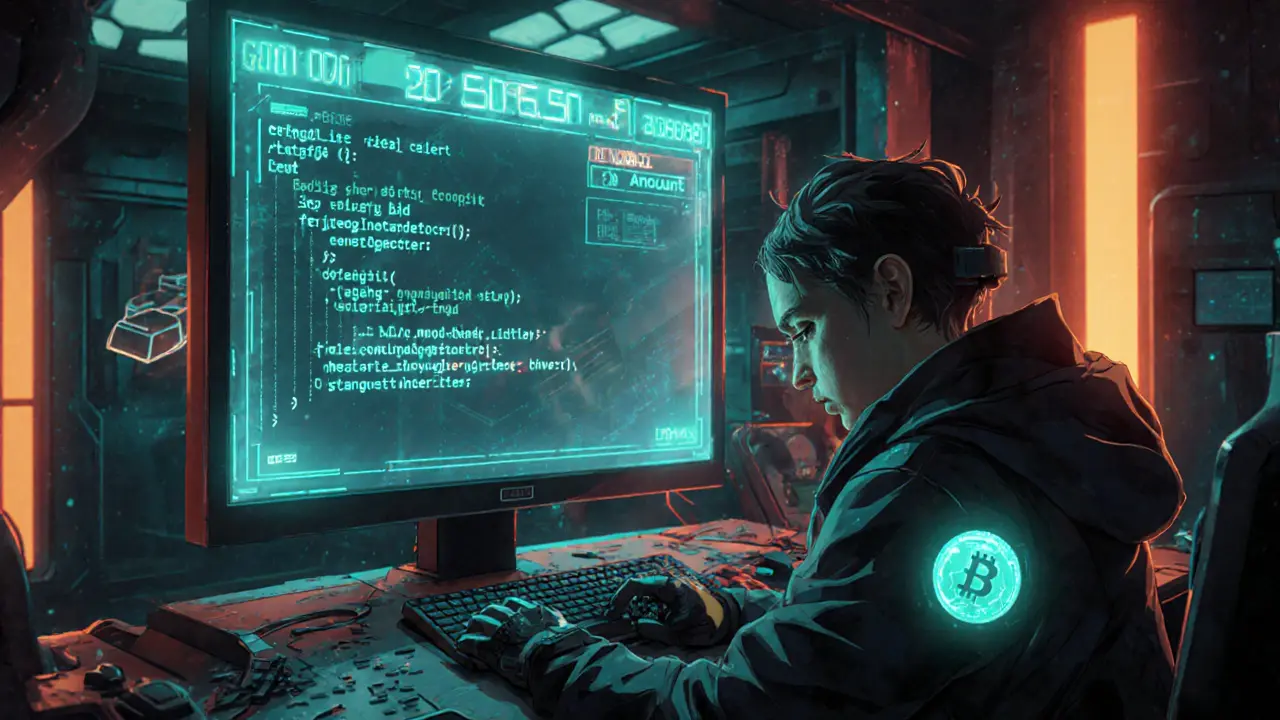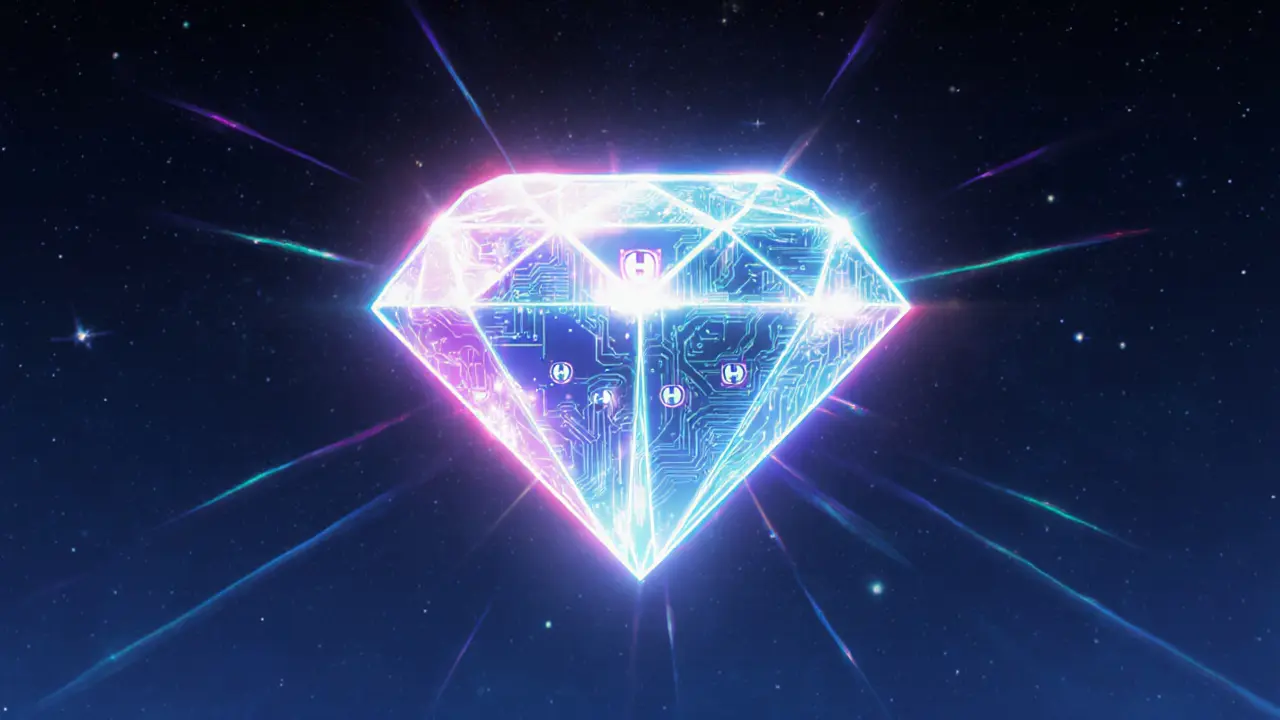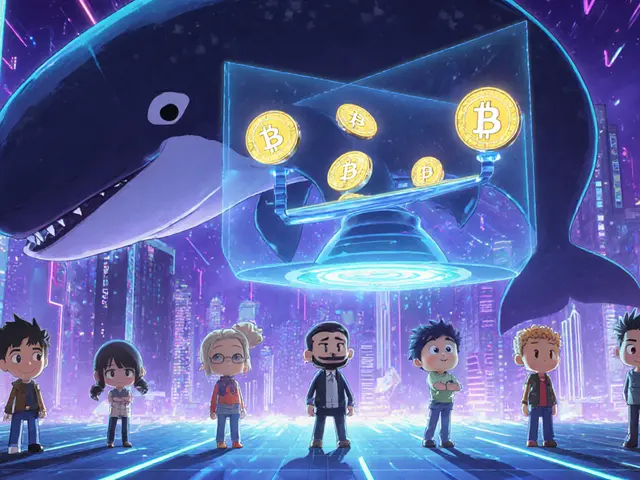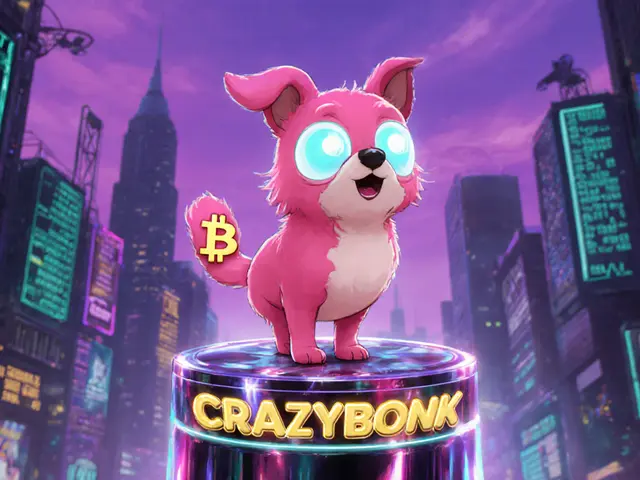Hacash Diamond (HACD) Calculator
Mining Reward Estimator
Estimate potential HACD rewards based on your bid amount and network conditions.
Estimated Results
Artwork Generator
Generate a sample HACD artwork from a six-letter code.
Quick facts
- Hacash Diamond (HACD) is a Proof‑of‑Work NFT that lives on the Hacash layer‑1 blockchain.
- Each HACD token contains a unique six‑letter inscription that also generates a piece of art.
- Mining occurs every 5th block via a HAC‑token auction; the max supply is under 1.7million by 2100.
- Market cap sits around $1.1million in 2025, with price volatility similar to other small‑cap crypto assets.
- HACD blends cryptocurrency, NFT ownership, and generative art into a single deflationary asset.
What is Hacash Diamond?
When you hear the term Hacash Diamond (HACD) is a unique non‑fungible token that also serves as a native currency on the Hacash blockchain. It is billed as “Bitcoin as an NFT” because it inherits Bitcoin‑style proof‑of‑work (PoW) security while delivering a one‑of‑a‑kind digital artwork for every token.
How the Hacash ecosystem fits together
The Hacash network implements a three‑coin monetary system:
- Bitcoin (BTC) - the original PoW coin.
- Hacash (HAC) - the utility token used for transaction fees and mining bids.
- Hacash Diamond (HACD) - the NFT‑style, indivisible asset.
All three run on the same layer‑1 PoW chain, which means HACD benefits from the same decentralization and security guarantees as BTC.
Technical backbone - Proof‑of‑Work NFT
The Proof‑of‑Work NFT is the core novelty. Unlike typical NFTs that are minted on top of a smart‑contract platform, HACD tokens are created directly by miners who solve PoW puzzles. The mining process incorporates a bidding auction that uses HAC tokens as the currency for bid submissions.
Key technical details:
- Full‑node miners must sync the entire blockchain before they can join the auction.
- Blocks whose height is divisible by 5 trigger a HACD‑mining round, roughly every 25 minutes.
- The highest bidder receives the right to confirm the next five blocks and claim the newly minted HACD.
- Difficulty scales with the total number of HACDs already minted, never decreasing.
Because difficulty is tied to supply rather than miner count, the system naturally becomes harder to mine as more HACDs enter circulation.
Mining configuration - the diamondminer
Mining HACD requires editing the hacash.config.ini file. The relevant section, diamondminer, includes parameters such as enable, reward_address, bid_password, min_bid, max_bid, and step_bid. Bids are expressed in the format amount:248, meaning 248 HAC must be locked for that auction.
Only full‑node participants can submit bids, which preserves decentralization but raises the entry barrier for casual investors.
Supply limits and deflationary outlook
Current projections show a maximum annual output of about 21000 HACDs, capping at under 1.7million tokens by the year 2100. This limited supply, combined with ever‑rising mining difficulty, creates a built‑in deflationary pressure that mirrors Bitcoin’s scarcity model.

Market performance in 2025
Price data from major exchanges illustrate typical crypto volatility:
- Bybit (June292025): $10.03 per HACD, market cap $1.14M.
- Bybit (Sept292025): $9.80 per HACD, market cap $1.16M (+0.16%).
- Kriptomat (EU): €7.88 per HACD, -4.54% 24‑hour change, volume €4,212.69.
These fluctuations track broader macro‑economic cues, regulatory news, and social‑media sentiment. Influencer mentions on X (formerly Twitter) have caused short‑term spikes, while regulatory announcements on mining restrictions tend to dampen price action.
Artistic side - generative art protocol
Each HACD token carries a six‑letter inscription (e.g., “ABCD12”). The generative art protocol reads this code and renders a unique visual piece. The standard governing this process is HIP‑10, which defines how artistic layers (protocol, HIP visualization, and optional art extensions) are combined.
Collectors therefore own both a financial asset and an irreplicable artwork, a dual value proposition that differentiates HACD from plain‑text NFTs on Ethereum.
How HACD stacks up against Bitcoin and regular NFTs
| Feature | Hacash Diamond (HACD) | Bitcoin (BTC) | ERC‑721 NFT |
|---|---|---|---|
| Consensus | Proof‑of‑Work (PoW) + auction‑based minting | Proof‑of‑Work (PoW) | Proof‑of‑Stake or PoW depending on chain |
| Supply cap | ~1.7M (2100) | 21M | Varies per collection |
| Art component | Generative 6‑letter artwork | None | Custom artwork per token |
| Mining requirement | Full‑node PoW + HAC bid auction | Full‑node PoW | Usually no mining (minted by creator) |
| Typical use case | Store of value + collectible art | Digital gold / settlement | Digital collectibles, game assets |
Potential advantages and hurdles
Advantages:
- Combines monetary scarcity with artistic uniqueness.
- PoW security reduces risk of centralization attacks.
- Deflationary supply may support long‑term price appreciation.
Challenges:
- Mining requires a full node and HAC bids, limiting casual participation.
- Market depth is shallow; price swings can be sharp.
- Regulatory uncertainty around NFTs and PoW mining could affect adoption.
Who might want to get involved?
Three typical personas appear in the community:
- Crypto collectors who value scarcity and want a unique piece of generative art.
- Miners already running HAC nodes who see extra revenue by bidding for HACD blocks.
- Artists exploring the HIP‑10 protocol to create algorithmic works that automatically mint as HACD tokens.
Next steps for interested readers
If you’re curious about acquiring or mining HACD, follow these checkpoints:
- Set up a full‑node Hacash client (download from the official GitHub repository).
- Fund the node’s wallet with enough HAC to meet the minimum bid (check the
diamondminerconfig for current thresholds). - Monitor the auction queue on the Hacash explorer and place bids when the block height mod5 equals0.
- Join the official Discord and X channels for real‑time sentiment signals.
Frequently Asked Questions
What makes HACD different from a regular NFT?
HACD is minted through a PoW mining auction, not by a smart‑contract creator. It also carries a six‑letter code that automatically generates unique artwork, merging financial scarcity with generative art.
Can I buy HACD on common exchanges?
Yes. HACD is listed on a few niche exchanges such as Bybit and Kriptomat. Liquidity is limited, so expect higher price impact compared with major coins.
Do I need to own HAC to mine HACD?
Exactly. Bids for the mining auction are made with HAC tokens. Your node must hold enough HAC to cover the minimum bid before you can compete for a block.
Is the supply of HACD truly limited?
Yes. The protocol caps total issuance at roughly 1.7million tokens by the year 2100, with a hard limit on daily minting (≈58 per day). Difficulty only rises, never falls.
How does HIP‑10 affect the artwork?
HIP‑10 defines the algorithm that transforms the six‑letter inscription into visual layers. Artists can customize the protocol layer, while the engine handles the visual rendering, ensuring every HACD is both unique and verifiable on‑chain.












Clint Barnett
October 3, 2025 AT 17:00 PMWelcome to the fascinating world of Hacash Diamond, where cryptographic rigor meets generative artistry, and every token carries the weight of a meticulously solved proof‑of‑work puzzle, a fact that often goes underappreciated by newcomers who skim headlines without digging into the technical subtleties, so let me paint a vivid picture that intertwines the economic incentives, the auction mechanics, and the aesthetic allure of the six‑letter inscription that births a unique piece of visual code, imagine a mining round that fires every fifth block like a rhythmic drumbeat, inviting full‑node operators to place HAC bids that are essentially locked stakes, the highest bidder then earns not only the right to confirm the next five blocks but also the privilege of minting a brand‑new HACD token, each of these tokens bears a 6‑character alphanumeric seed that the HIP‑10 protocol transforms into a kaleidoscopic artwork, which is anchored immutably on‑chain, creating a delightful blend of scarcity and creativity, the supply cap of roughly 1.7 million tokens by the year 2100 imposes a hard ceiling that mirrors Bitcoin’s scarcity model, while the difficulty curve ascends relentlessly, ensuring that newer HACDs become progressively harder to mint, this deflationary pressure, combined with the PoW security inherited from the broader Hacash ecosystem, offers a compelling narrative for long‑term value preservation, collectors can appreciate the dual nature of HACD as both a store of value and a collectible art piece, and miners can supplement their HAC earnings with the occasional diamond, the market liquidity remains thin, which means price swings can be dramatic, yet it also opens opportunities for early adopters to shape the community’s perception, as you explore the official documentation, pay attention to the diamondminer configuration parameters such as min_bid and step_bid, because they determine the economic threshold for participation, finally, join the Discord and X channels to stay abreast of sentiment signals and network upgrades, and you’ll find that the community thrives on a mix of technical curiosity and artistic passion, making HACD a unique case study at the intersection of finance, cryptography, and digital art.
Jacob Anderson
October 6, 2025 AT 00:33 AMOh sure, because we all have endless spare HAC just lying around to throw into an auction for a fancy pixel‑art token – what could possibly go wrong?
Kate Nicholls
October 8, 2025 AT 08:06 AMWhile the sarcasm is noted, the real bottleneck remains the full‑node requirement; casual investors without technical know‑how are effectively excluded from minting.
Carl Robertson
October 10, 2025 AT 15:40 PMAnd let’s not forget the drama that erupts when a high‑roller swoops in, outbidding everyone and leaving the rest of the community to watch their bids evaporate like mist in a storm.
Rajini N
October 12, 2025 AT 23:13 PMIf you’re looking to get hands‑on with HACD, start by setting up a full‑node client from the official repository, fund your wallet with enough HAC to meet the current minimum bid, and keep an eye on the block height modulo‑5 to know when the auction window opens – it’s as straightforward as it sounds, provided you’ve got the patience for syncing the chain.
Kate Roberge
October 15, 2025 AT 06:46 AMHonestly, the whole auction model feels like a gimmick designed to give the illusion of decentralisation while rewarding only those with deep pockets.
april harper
October 17, 2025 AT 14:20 PMHACD looks like a niche experiment.
Oreoluwa Towoju
October 19, 2025 AT 21:53 PMDoes anyone know the exact current min_bid value? I’m trying to plan my next move.
Jason Brittin
October 22, 2025 AT 05:26 AMCool stuff! 🚀 If you’re new, just remember the block height mod‑5 rule and you’ll be good to go. 😎
Amie Wilensky
October 24, 2025 AT 13:00 PMWow!!!, this is absolutely fascinating,,, but!!!, is there any official source for the exact reward formula???!!!
Katrinka Scribner
October 26, 2025 AT 20:33 PMYesss, love the vibe here! 😊👍 gonna dive in soon, hope i don’t mess up lol.